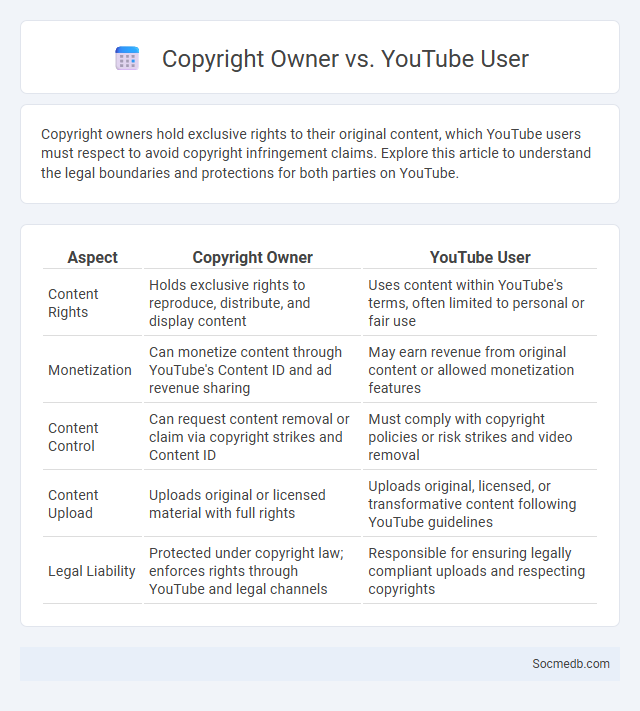
Photo illustration: Copyright Owner vs YouTube User
Copyright owners hold exclusive rights to their original content, which YouTube users must respect to avoid copyright infringement claims. Explore this article to understand the legal boundaries and protections for both parties on YouTube.
Table of Comparison
| Aspect | Copyright Owner | YouTube User |
|---|---|---|
| Content Rights | Holds exclusive rights to reproduce, distribute, and display content | Uses content within YouTube's terms, often limited to personal or fair use |
| Monetization | Can monetize content through YouTube's Content ID and ad revenue sharing | May earn revenue from original content or allowed monetization features |
| Content Control | Can request content removal or claim via copyright strikes and Content ID | Must comply with copyright policies or risk strikes and video removal |
| Content Upload | Uploads original or licensed material with full rights | Uploads original, licensed, or transformative content following YouTube guidelines |
| Legal Liability | Protected under copyright law; enforces rights through YouTube and legal channels | Responsible for ensuring legally compliant uploads and respecting copyrights |
Understanding Copyright Ownership on YouTube
Understanding copyright ownership on YouTube is essential for content creators, as the platform strictly enforces copyright laws to protect original works. Copyright on YouTube typically belongs to the creator of the original content, but uploading third-party material without permission can lead to strikes, video removal, or channel termination. Utilizing YouTube's Content ID system allows rights holders to manage their copyrighted content by monetizing, tracking, or blocking unauthorized use across the platform.
Who Qualifies as a Copyright Owner?
A copyright owner is typically the individual or entity who created the original work or holds the legal rights through assignment or employment. In social media, content creators such as photographers, videographers, and writers automatically qualify as copyright owners upon creation. Businesses or influencers may also own copyrights if they have legally obtained or commissioned the content, establishing clear ownership for protection and enforcement.
Rights and Responsibilities of YouTube Users
YouTube users hold the right to create, share, and monetize original content while benefiting from community guidelines that protect against harassment and copyright infringement. They bear the responsibility to respect intellectual property laws, avoid spreading misinformation, and adhere to YouTube's policies to maintain a safe and respectful environment. Balancing these rights and responsibilities ensures a sustainable platform fostering creativity and accountability.
Overview of YouTube’s Copyright Claim Process
YouTube's copyright claim process involves identifying and managing content that may infringe on copyrighted material uploaded by users. When a claim is triggered, the copyright owner can choose to monetize, track, or block the video according to YouTube's Content ID system. Your rights and options include disputing the claim if you believe it is incorrect or seeking permission to use the copyrighted content legally.
How Copyright Owners File Claims Against Users
Copyright owners file claims against users on social media platforms by submitting detailed infringement reports through the platform's designated reporting tools. These claims require precise identification of copyrighted content, proof of ownership, and URLs or screenshots of the infringing material. Social media companies review these claims and may remove the content, issue warnings, or suspend accounts based on the platform's copyright enforcement policies.
Types of Copyright Claims on YouTube
YouTube copyright claims primarily include Content ID claims, manual copyright strikes, and community guideline strikes related to copyrighted material. Content ID claims automatically detect copyrighted audio, video, or images in uploaded content, allowing rights holders to monetize, block, or track usage. Manual copyright strikes result from formal complaints by copyright owners and can lead to channel penalties or termination if repeated.
Fair Use: What YouTube Users Need to Know
Fair Use on YouTube allows users to legally incorporate copyrighted content in their videos for purposes like commentary, criticism, or parody without needing permission from the copyright holder. You should understand the four factors of Fair Use: the purpose and character of your use, the nature of the copyrighted work, the amount used, and the effect on the market value of the original work. Knowing these guidelines helps you protect your content while respecting intellectual property laws on the platform.
Disputing a Copyright Claim: User Options
Users disputing a copyright claim on social media platforms can submit a counter-notification to restore their content if they believe the claim is mistaken or invalid. Platforms like YouTube or Facebook require the disputing party to provide a detailed explanation and confirm under penalty of perjury that their content does not infringe copyright laws. If the copyright owner does not take further legal action within a specified period, the disputed content is reinstated, ensuring user rights are protected while maintaining compliance with copyright regulations.
Consequences of Copyright Claims for YouTube Users
Copyright claims on YouTube can lead to video removal, demonetization, or channel strikes, severely impacting your content's visibility and revenue potential. Repeated infringements may result in account suspension or termination, affecting your ability to share videos and engage with your audience. Understanding copyright policies helps you protect your channel and avoid legal repercussions while maintaining your creative presence on the platform.
Best Practices to Avoid Copyright Infringement on YouTube
To avoid copyright infringement on YouTube, always use original content or obtain proper licenses for music, videos, and images included in your uploads. Ensure your content adheres to YouTube's Fair Use policies by providing commentary, criticism, or transformative content when using third-party materials. Protect your channel by regularly reviewing YouTube's copyright guidelines and utilizing tools like Content ID to detect potential infringements before publishing.
 socmedb.com
socmedb.com